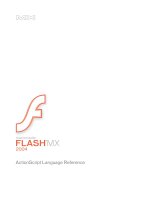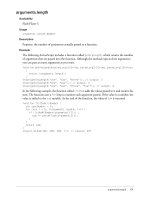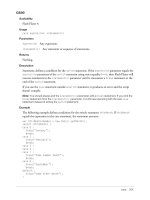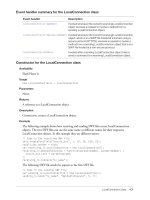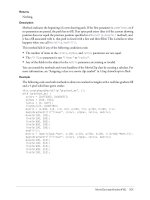Tài liệu Flash: ActionScript Language Reference- P10 ppt
Bạn đang xem bản rút gọn của tài liệu. Xem và tải ngay bản đầy đủ của tài liệu tại đây (339.09 KB, 100 trang )
TextField.onChanged 901
TextField.onChanged
Availability
Flash Player 6.
Usage
my_txt.onChanged = function(){
// your statements here
}
myListenerObj.onChanged = function(){
// your statements here
}
Parameters
None.
Returns
The instance name of the text field.
Description
Event handler/listener; invoked when the content of a text field changes. By default, it is
undefined; you can define it in a script.
A reference to the text field instance is passed as a parameter to the
onChanged
handler. You can
capture this data by putting a parameter in the event handler method. For example, the following
code uses
textfield_txt
as the parameter that is passed to the
onChanged
event handler. The
parameter is then used in a
trace()
statement to send the instance name of the text field to the
Output panel:
this.createTextField("myInputText_txt", 99, 10, 10, 300, 20);
myInputText_txt.border = true;
myInputText_txt.type = "input";
myInputText_txt.onChanged = function(textfield_txt:TextField) {
trace("the value of "+textfield_txt._name+" was changed. New value is:
"+textfield_txt.text);
};
The
onChanged
handler is fired only when the change results from user interaction; for example,
when the user is typing something on the keyboard, changing something in the text field using
the mouse, or selecting a menu item. Programmatic changes to the text field do not trigger the
onChanged
event because the code recognizes changes that are made to the text field.
902 Chapter 2: ActionScript Language Reference
TextField.onKillFocus
Availability
Flash Player 6.
Usage
my_txt.onKillFocus = function(newFocus:Object){
// your statements here
}
Parameters
newFocus
The object that is receiving the focus.
Returns
Nothing.
Description
Event handler; invoked when a text field loses keyboard focus. The
onKillFocus
method receives
one parameter,
newFocus
, which is an object representing the new object receiving the focus. If
no object receives the focus,
newFocus
contains the value
null
.
Example
The following example creates two text fields called
first_txt
and
second_txt
. When you give
focus to a text field, information about the text field with current focus and the text field that lost
focus is displayed in the Output panel.
this.createTextField("first_txt", 1, 10, 10, 300, 20);
first_txt.border = true;
first_txt.type = "input";
this.createTextField("second_txt", 2, 10, 40, 300, 20);
second_txt.border = true;
second_txt.type = "input";
first_txt.onKillFocus = function(newFocus:Object) {
trace(this._name+" lost focus. New focus changed to: "+newFocus._name);
};
first_txt.onSetFocus = function(oldFocus:Object) {
trace(this._name+" gained focus. Old focus changed from: "+oldFocus._name);
}
See Also
TextField.onSetFocus
TextField.onScroller 903
TextField.onScroller
Availability
Flash Player 6.
Usage
my_txt.onScroller = function(textFieldInstance:TextField){
// your statements here
}
myListenerObj.onScroller = function(textFieldInstance:TextField){
// your statements here
}
Parameters
textFieldInstance
A reference to the TextField object whose scroll position was changed.
Returns
Nothing.
Description
Event handler/listener; invoked when one of the text field scroll properties changes.
A reference to the text field instance is passed as a parameter to the
onScroller
handler. You can
capture this data by putting a parameter in the event handler method. For example, the following
code uses
my_txt
as the parameter that is passed to the
onScroller
event handler. The parameter
is then used in a
trace()
statement to send the instance name of the text field to the Output
panel.
myTextField.onScroller = function (my_txt:TextField) {
trace (my_txt._name + " scrolled");
};
The
TextField.onScroller
event handler is commonly used to implement scroll bars. Scroll
bars typically have a thumb or other indicator that shows the current horizontal or vertical
scrolling position in a text field. Text fields can be navigated using the mouse and keyboard,
which causes the scroll position to change. The scroll bar code needs to be notified if the scroll
position changes because of such user interaction, which is what
TextField.onScroller
is used
for.
onScroller
is called whether the scroll position changed because of a users interaction with the
text field, or programmatic changes. The
onChanged
handler fires only if a user interaction causes
the change. These two options are necessary because often one piece of code changes the scrolling
position, while the scroll bar code is unrelated and won't know that the scroll position changed
without being notified.
904 Chapter 2: ActionScript Language Reference
Example
The following example creates a text field called
my_txt
, and uses two buttons called
scrollUp_btn
and
scrollDown_btn
to scroll the contents of the text field. When the
onScroller
event handler is called, a trace statement is used to display information in the
Output panel. Create two buttons with instance names
scrollUp_btn
and
scrollDown_btn,
and add the following ActionScript to your FLA or AS file:
this.createTextField("scroll_txt", this.getNextHighestDepth(), 10, 10, 160,
20);
this.createTextField("my_txt", this.getNextHighestDepth(), 10, 30, 320, 240);
my_txt.multiline = true;
my_txt.wordWrap = true;
for (var i = 0; i<10; i++) {
my_txt.text += "Lorem ipsum dolor sit amet, consectetuer adipiscing elit,
sed diam nonummy nibh euismod tincidunt ut laoreet dolore magna aliquam erat
volutpat.";
}
scrollUp_btn.onRelease = function() {
my_txt.scroll--;
};
scrollDown_btn.onRelease = function() {
my_txt.scroll++;
};
my_txt.onScroller = function() {
trace("onScroller called");
scroll_txt.text = my_txt.scroll+" of "+my_txt.maxscroll;
};
See also
TextField.hscroll, TextField.maxhscroll, TextField.maxscroll, TextField.scroll
TextField.onSetFocus 905
TextField.onSetFocus
Availability
Flash Player 6.
Usage
my_txt.onSetFocus = function(oldFocus:Object){
// your statements here
}
Parameters
oldFocus
The object to lose focus.
Returns
Nothing.
Description
Event handler; invoked when a text field receives keyboard focus. The
oldFocus
parameter is the
object that loses the focus. For example, if the user presses the Tab key to move the input focus
from a button to a text field,
oldFocus
contains the text field instance.
If there is no previously focused object,
oldFocus
contains a
null
value.
Example
See the example for TextField.onKillFocus.
See Also
TextField.onKillFocus
906 Chapter 2: ActionScript Language Reference
TextField._parent
Availability
Flash Player 6.
Usage
my_txt._parent.property
_parent.property
Description
Property; a reference to the movie clip or object that contains the current text field or object. The
current object is the one containing the ActionScript code that references
_parent
.
Use
_parent
to specify a relative path to movie clips or objects that are above the current text
field. You can use
_parent
to climb up multiple levels in the display list as in the following:
_parent._parent._alpha = 20;
Example
The following ActionScript creates two text fields and outputs information about the
_parent
of
each object. The first text field,
first_txt
, is created on the main Timeline. The second text
field,
second_txt
, is created inside the movie clip called
holder_mc
.
this.createTextField("first_txt", this.getNextHighestDepth(), 10, 10, 160,
22);
first_txt.border = true;
trace(first_txt._name+"'s _parent is: "+first_txt._parent);
this.createEmptyMovieClip("holder_mc", this.getNextHighestDepth());
holder_mc.createTextField("second_txt", holder_mc.getNextHighestDepth(), 10,
40, 160, 22);
holder_mc.second_txt.border = true;
trace(holder_mc.second_txt._name+"'s _parent is:
"+holder_mc.second_txt._parent);
The following information is displayed in the Output panel:
first_txt's _parent is: _level0
second_txt's _parent is: _level0.holder_mc
See also
Button._parent, MovieClip._parent, _root, targetPath()
TextField.password 907
TextField.password
Availability
Flash Player 6.
Usage
my_txt.password:Boolean
Description
Property; if the value of
password
is
true
, the text field is a password text field and hides the
input characters using asterisks instead of the actual characters. If
false
, the text field is not a
password text field. When password mode is enabled, the Cut and Copy commands and their
corresponding keyboard accelerators will not function. This security mechanism prevents an
unscrupulous user from using the shortcuts to discover a password on an unattended computer.
Example
The following example creates two text fields:
username_txt
and
password_txt
. Text is entered
into both text fields; however,
password_txt
has the
password
property set to
true
. Therefore,
the characters display as asterisks instead of as characters in the
password_txt
field.
this.createTextField("username_txt", this.getNextHighestDepth(), 10, 10, 100,
22);
username_txt.border = true;
username_txt.type = "input";
username_txt.maxChars = 16;
username_txt.text = "hello";
this.createTextField("password_txt", this.getNextHighestDepth(), 10, 40, 100,
22);
password_txt.border = true;
password_txt.type = "input";
password_txt.maxChars = 16;
password_txt.password = true;
password_txt.text = "world";
908 Chapter 2: ActionScript Language Reference
TextField._quality
Availability
Flash Player 6.
Usage
my_txt._quality:String
Description
Property (global); sets or retrieves the rendering quality used for a SWF file. Device fonts are
always aliased and, therefore, are unaffected by the
_quality
property.
Note: Although you can specify this property for a TextField object, it is actually a global property,
and you can specify its value simply as
_quality
. For more information, see the _quality property.
The
_quality
property can be set to the following values:
•
"LOW"
Low rendering quality. Graphics are not anti-aliased, and bitmaps are not smoothed.
•
"MEDIUM"
Medium rendering quality. Graphics are anti-aliased using a 2 x 2 pixel grid, but
bitmaps are not smoothed. Suitable for movies that do not contain text.
•
"HIGH"
High rendering quality. Graphics are anti-aliased using a 4 x 4 pixel grid, and bitmaps
are smoothed if the movie is static. This is the default rendering quality setting used by Flash.
•
"BEST"
Very high rendering quality. Graphics are anti-aliased using a 4 x 4 pixel grid and
bitmaps are always smoothed.
Example
The following example sets the rendering quality to
LOW
:
my_txt._quality = "LOW";
TextField.removeListener() 909
TextField.removeListener()
Availability
Flash Player 6.
Usage
my_txt.removeListener(listener:Object)
Parameters
listener
The object that will no longer receive notifications from TextFie l d . o n C h a n g e d or
TextField.onScroller.
Returns
If
listener
was successfully removed, the method returns a
true
value. If
listener
was not
successfully removed (for example, if
listener
was not on the TextField object’s listener list), the
method returns a value of
false
.
Description
Method; removes a listener object previously registered to a text field instance with
TextField.addListener().
Example
The following example creates an input text field called
my_txt
. When the user types into the
field, information about the number of characters in the text field is displayed in the Output
panel. If the user clicks the
removeListener_btn
instance, then the listener is removed and
information is no longer displayed.
this.createTextField("my_txt", this.getNextHighestDepth(), 10, 10, 160, 20);
my_txt.border = true;
my_txt.type = "input";
var txtListener:Object = new Object();
txtListener.onChanged = function(textfield_txt:TextField) {
trace(textfield_txt+" changed. Current length is: "+textfield_txt.length);
};
my_txt.addListener(txtListener);
removeListener_btn.onRelease = function() {
trace("Removing listener...");
if (!my_txt.removeListener(txtListener)) {
trace("Error! Unable to remove listener");
}
};
910 Chapter 2: ActionScript Language Reference
TextField.removeTextField()
Availability
Flash Player 6.
Usage
my_txt.removeTextField() : Void
Description
Method; removes the text field specified by
my_txt
. This operation can only be performed on a
text field that was created with MovieClip.createTextField(). When you call this method, the text
field is removed. This method is similar to
MovieClip.removeMovieClip()
.
Example
The following example creates a text field that you can remove from the Stage when you click the
remove_btn instance. Create a button and call it
remove_btn
, and then add the following
ActionScript to your FLA or AS file.
this.createTextField("my_txt", this.getNextHighestDepth(), 10, 10, 300, 22);
my_txt.text = new Date().toString();
my_txt.border = true;
remove_btn.onRelease = function() {
my_txt.removeTextField();
};
TextField.replaceSel() 911
TextField.replaceSel()
Availability
Flash Player 6.
Usage
my_txt.replaceSel(text:String) : Void
Parameters
text
A string.
Returns
Nothing.
Description
Method; replaces the current selection with the contents of the
text
parameter. The text is
inserted at the position of the current selection, using the current default character format and
default paragraph format. The text is not treated as HTML, even if the text field is an HTML
text field.
You can use the
replaceSel()
method to insert and delete text without disrupting the character
and paragraph formatting of the rest of the text.
You must use Selection.setFocus() to focus the field before issuing this command.
Example
The following example code creates a multiline text field with text on the Stage. When you select
some text and then right-click or Control-click over the text field, you can select Enter current
date from the context menu. This selection calls a function that replaces the selected text with the
current date.
this.createTextField("my_txt", this.getNextHighestDepth(), 10, 10, 320, 240);
my_txt.border = true;
my_txt.wordWrap = true;
my_txt.multiline = true;
my_txt.type = "input";
my_txt.text = "Select some sample text from the text field and then right-
click/control click and select 'Enter current date' from the context menu to
replace the currently selected text with the current date.";
var my_cm:ContextMenu = new ContextMenu();
my_cm.customItems.push(new ContextMenuItem("Enter current date", enterDate));
function enterDate(obj:Object, menuItem:ContextMenuItem) {
var today_str:String = new Date().toString();
var date_str:String = today_str.split(" ", 3).join(" ");
my_txt.replaceSel(date_str);
}
my_txt.menu = my_cm;
See also
Selection.setFocus()
912 Chapter 2: ActionScript Language Reference
TextField.replaceText()
Availability
Flash Player 7.
Usage
my_txt.replaceText(beginIndex:Number, endIndex:Number, text:String) : Void
Description
Method; replaces a range of characters, specified by the
beginIndex
and
endIndex
parameters, in
the specified text field with the contents of the
text
parameter.
Example
The following example creates a text field called
my_txt
and assigns the text to
the field. The
indexOf()
method is used to find the first occurrence of the specified symbol (
@
).
If the symbol is found, the specified text (between the index of 0 and the symbol) replaces with
the string
bird
. If the symbol is not found, an error message is displayed in the Output panel.
this.createTextField("my_txt", this.getNextHighestDepth(), 10, 10, 320, 22);
my_txt.autoSize = true;
my_txt.text = "";
var symbol:String = "@";
var symbolPos:Number = my_txt.text.indexOf(symbol);
if (symbolPos>-1) {
my_txt.replaceText(0, symbolPos, "bird");
} else {
trace("symbol '"+symbol+"' not found.");
}
TextField.restrict 913
TextField.restrict
Availability
Flash Player 6.
Usage
my_txt.restrict:String
Description
Property; indicates the set of characters that a user may enter into the text field. If the value of the
restrict
property is
null
, you can enter any character. If the value of the
restrict
property is
an empty string, you can’t enter any character. If the value of the
restrict
property is a string of
characters, you can enter only characters in the string into the text field. The string is scanned
from left to right. A range may be specified using the dash (-). This only restricts user interaction;
a script may put any text into the text field. This property does not synchronize with the Embed
Font Outlines check boxes in the Property inspector.
If the string begins with ^, all characters are initially accepted and succeeding characters in the
string are excluded from the set of accepted characters. If the string does not begin with ^, no
characters are initially accepted and succeeding characters in the string are included in the set of
accepted characters.
Example
The following example allows only uppercase characters, spaces, and numbers to be entered into
a text field:
my_txt.restrict = "A-Z 0-9";
The following example includes all characters, but excludes lowercase letters:
my_txt.restrict = "^a-z";
You can use a backslash to enter a ^ or - verbatim. The accepted backslash sequences are \-, \^ or
\\. The backslash must be an actual character in the string, so when specified in ActionScript, a
double backslash must be used. For example, the following code includes only the dash (-) and
caret (^):
my_txt.restrict = "\\-\\^";
The ^ may be used anywhere in the string to toggle between including characters and excluding
characters. The following code includes only uppercase letters, but excludes the uppercase
letter Q:
my_txt.restrict = "A-Z^Q";
You can use the
\u
escape sequence to construct
restrict
strings. The following code includes
only the characters from ASCII 32 (space) to ASCII 126 (tilde).
my_txt.restrict = "\u0020-\u007E";
914 Chapter 2: ActionScript Language Reference
TextField._rotation
Availability
Flash Player 6.
Usage
my_txt._rotation:Number
Description
Property; the rotation of the text field, in degrees, from its original orientation. Values from
0 to 180 represent clockwise rotation; values from 0 to -180 represent counterclockwise rotation.
Values outside this range are added to or subtracted from 360 to obtain a value within the range.
For example, the statement
my_txt._rotation = 450
is the same as
my_txt._rotation = 90
.
Rotation values are not supported for text files that use device fonts. You must use embedded
fonts to use
_rotation
with a text field.
Example
In this example, you need to create a dynamic text field called
my_txt
, and then use the following
ActionScript to embed fonts and rotate the text field. The reference to
my font
refers to a Font
symbol in the library, with linkage set to
my font
.
var my_fmt:TextFormat = new TextFormat();
my_fmt.font = "my font";
this.createTextField("my_txt", this.getNextHighestDepth(), 10, 10, 160, 120);
my_txt.wordWrap = true;
my_txt.embedFonts = true;
my_txt.text = "Hello world";
my_txt.setTextFormat(my_fmt);
my_txt._rotation = 45;
Apply additional formatting for the text field using the TextFormat class.
See also
Button._rotation, MovieClip._rotation
TextField.scroll 915
TextField.scroll
Availability
Flash Player 6.
Usage
my_txt.scroll
Description
Property; defines the vertical position of text in a text field. The
scroll
property is useful for
directing users to a specific paragraph in a long passage, or creating scrolling text fields. This
property can be retrieved and modified.
The units of horizontal scrolling are pixels, while the units of vertical scrolling are lines.
Horizontal scrolling is measured in pixels because most fonts you typically use are proportionally
spaced; meaning, the characters can have different widths. Flash performs vertical scrolling by line
because users usually want to see a line of text in its entirety, as opposed to seeing a partial line.
Even if there are multiple fonts on a line, the height of the line adjusts to fit the largest font in use.
For more information on scrolling text, see “Creating scrolling text” in Using Flash.
Example
The following example sets the maximum value for the scrolling text field
my_txt
. Create two
buttons,
scrollUp_btn
and
scrollDown_btn,
to scroll the text field. Add the following
ActionScript to your FLA or AS file.
this.createTextField("scroll_txt", this.getNextHighestDepth(), 10, 10, 160,
20);
this.createTextField("my_txt", this.getNextHighestDepth(), 10, 30, 320, 240);
my_txt.multiline = true;
my_txt.wordWrap = true;
for (var i = 0; i<10; i++) {
my_txt.text += "Lorem ipsum dolor sit amet, consectetuer adipiscing elit,
sed diam nonummy nibh euismod tincidunt ut laoreet dolore magna aliquam erat
volutpat.";
}
scrollUp_btn.onRelease = function() {
my_txt.scroll--;
scroll_txt.text = my_txt.scroll+" of "+my_txt.maxscroll;
};
scrollDown_btn.onRelease = function() {
my_txt.scroll++;
scroll_txt.text = my_txt.scroll+" of "+my_txt.maxscroll;
};
See also
TextField.hscroll, TextField.maxscroll
916 Chapter 2: ActionScript Language Reference
TextField.selectable
Availability
Flash Player 6.
Usage
my_txt.selectable:Boolean
Description
Property; a Boolean value that indicates whether the text field is selectable. The value
true
indicates that the text is selectable. The
selectable
property controls whether a text field is
selectable, and not whether a text field is editable. A dynamic text field can be selectable even if
it's not editable. If a dynamic text field is not selectable, that means you cannot select its text.
If selectable is set to
false
, the text in the text field does not respond to selection commands
from the mouse or keyboard, and the text cannot be copied using the Copy command. If
selectable is set to
true
, the text in the text field can be selected using the mouse or keyboard. You
can select text this way even if the text field is a dynamic text field instead of an input text field.
The text can be copied using the Copy command.
Example
The following example creates a selectable text field that constantly updates with the current date
and time.
this.createTextField("date_txt", this.getNextHighestDepth(), 10, 10, 100, 22);
date_txt.autoSize = true;
date_txt.selectable = false;
var date_interval:Number = setInterval(updateTime, 500, date_txt);
function updateTime(my_txt:TextField) {
my_txt.text = new Date().toString();
}
TextField.setNewTextFormat() 917
TextField.setNewTextFormat()
Availability
Flash Player 6.
Usage
my_txt.setNewTextFormat(textFormat:TextFormat) : Void
Parameters
textFormat
A TextFormat object.
Returns
Nothing.
Description
Method; sets the default new text format of a text field; that is, the text format to be used for
newly inserted text, such as text inserted with the
replaceSel()
method or text entered by a
user. When text is inserted, the newly inserted text is assigned the default new text format.
The new default text format is specified by
textFormat
, which is a TextFormat object.
Example
In the following example, a new text field (called
my_txt
) is created at runtime and several
properties are set. The format of the newly inserted text is applied.
var my_fmt:TextFormat = new TextFormat();
my_fmt.bold = true;
my_fmt.font = "Arial";
my_fmt.color = 0xFF9900;
this.createTextField("my_txt", 999, 0, 0, 400, 300);
my_txt.wordWrap = true;
my_txt.multiline = true;
my_txt.border = true;
my_txt.type = "input";
my_txt.setNewTextFormat(my_fmt);
my_txt.text = "Oranges are a good source of vitamin C";
See also
TextField.getNewTextFormat(), TextField.getTextFormat(),
TextField.setTextFormat()
918 Chapter 2: ActionScript Language Reference
TextField.setTextFormat()
Availability
Flash Player 6.
Usage
my_txt.setTextFormat (textFormat:TextFormat) : Void
my_txt.setTextFormat (index:Number, textFormat:TextFormat) : Void
my_txt.setTextFormat (beginIndex:Number, endIndex:Number,
textFormat:TextFormat) : Void
Parameters
textFormat
A TextFormat object, which contains character and paragraph formatting
information.
index
An integer that specifies a character within
my_txt
.
beginIndex
An integer.
endIndex
An integer that specifies the first character after the desired text span.
Returns
Nothing.
Description
Method; applies the text formatting specified by textFormat to some or all of the text in a text
field.
textFormat
must be a TextFormat object that specifies the text formatting changes desired.
Only the non-null properties of textFormat are applied to the text field. Any property of
textFormat
that is set to null will not be applied. By default, all of the properties of a newly
created TextFormat object are set to
null
.
There are two types of formatting information in a TextFormat object: character level, and
paragraph level formatting. Each character in a text field might have its own character formatting
settings, such as font name, font size, bold, and italic.
For paragraphs, the first character of the paragraph is examined for the paragraph formatting
settings for the entire paragraph. Examples of paragraph formatting settings are left margin, right
margin, and indentation.
The
setTextFormat()
method changes the text formatting applied to an individual character, to
a range of characters, or to the entire body of text in a text field.
Usage 1: Applies the properties of
textFormat
to all text in the text field.
Usage 2: Applies the properties of
textFormat
to the character at position index.
Usage 3: Applies the properties of the
textFormat
parameter to the span of text from the
beginIndex parameter to the endIndex parameter.
TextField.setTextFormat() 919
Notice that any text inserted manually by the user, or replaced by means of TextField.replaceSel(),
receives the text field's default formatting for new text, and not the formatting specified for the
text insertion point. To set a text field’s default formatting for new text, use
TextFi e l d . s e t Ne w Te x t Fo r m a t ( ) .
Example
The following example sets the text format for two different strings of text. The
setTextFormat
()
method is called and applied to the
my_txt
text field.
var format1_fmt:TextFormat = new TextFormat();
format1_fmt.font = "Arial";
var format2_fmt:TextFormat = new TextFormat();
format2_fmt.font = "Courier";
var string1:String = "Sample string number one."+newline;
var string2:String = "Sample string number two."+newline;
this.createTextField("my_txt", this.getNextHighestDepth(), 0, 0, 300, 200);
my_txt.multiline = true;
my_txt.wordWrap = true;
my_txt.text = string1;
var firstIndex:Number = my_txt.length;
my_txt.text += string2;
var secondIndex:Number = my_txt.length;
my_txt.setTextFormat(0, firstIndex, format1_fmt);
my_txt.setTextFormat(firstIndex, secondIndex, format2_fmt);
See also
TextFi e l d . s e t Ne w Te x t Fo r m a t ( ) , TextFormat class
920 Chapter 2: ActionScript Language Reference
TextField.styleSheet
Availability
Flash Player 7.
Usage
my_txt.styleSheet = TextField StyleSheet
Description
Property; attaches a style sheet to the text field specified by
my_txt
. For information on creating
style sheets, see the TextField.StyleSheet class entry and “Formatting text with Cascading Style
Sheets” in Using ActionScript in Flash.
The style sheet associated with a text field may be changed at any time. If the style sheet in use is
changed, the text field is redrawn using the new style sheet. The style sheet may be set to
null
or
undefined
to remove the style sheet. If the style sheet in use is removed, the text field is redrawn
without a style sheet. The formatting done by a style sheet is not retained if the style sheet is
removed.
Example
The following example creates a new text field at runtime, called
news_txt
. Three buttons on the
Stage,
css1_btn
,
css2_btn
and
clearCss_btn
, are used to change the style sheet that is applied
to
news_txt
, or clear the style sheet from the text field. Add the following ActionScript to your
FLA or AS file:
this.createTextField("news_txt", this.getNextHighestDepth(), 0, 0, 300, 200);
news_txt.wordWrap = true;
news_txt.multiline = true;
news_txt.html = true;
var newsText:String = "<p class='headline'>Description</p> Method; starts
loading the CSS file into styleSheet. The load operation is asynchronous;
use the <span class='bold'>TextField.StyleSheet.onLoad</span> callback
handler to determine when the file has finished loading. <span
class='important'>The CSS file must reside in exactly the same domain as the
SWF file that is loading it.</span> For more information about restrictions
on loading data across domains, see Flash Player security features.";
news_txt.htmlText = newsText;
css1_btn.onRelease = function() {
var styleObj:TextField.StyleSheet = new TextField.StyleSheet();
styleObj.onLoad = function(success:Boolean) {
if (success) {
news_txt.styleSheet = styleObj;
news_txt.htmlText = newsText;
}
};
styleObj.load("styles.css");
};
css2_btn.onRelease = function() {
var styleObj:TextField.StyleSheet = new TextField.StyleSheet();
styleObj.onLoad = function(success:Boolean) {
TextField.styleSheet 921
if (success) {
news_txt.styleSheet = styleObj;
news_txt.htmlText = newsText;
}
};
styleObj.load("styles2.css");
};
clearCss_btn.onRelease = function() {
news_txt.styleSheet = undefined;
news_txt.htmlText = newsText;
};
The following styles are applied to the text field. Save the following two CSS files in the same
directory as the FLA or AS file you created previously:
/* in styles.css */
.important {
color: #FF0000;
}
.bold {
font-weight: bold;
}
.headline {
color: #000000;
font-family: Arial,Helvetica,sans-serif;
font-size: 18px;
font-weight: bold;
display: block;
}
/* in styles2.css */
.important {
color: #FF00FF;
}
.bold {
font-weight: bold;
}
.headline {
color: #00FF00;
font-family: Arial,Helvetica,sans-serif;
font-size: 18px;
font-weight: bold;
display: block;
}
922 Chapter 2: ActionScript Language Reference
TextField.tabEnabled
Availability
Flash Player 6.
Usage
my_txt.tabEnabled:Boolean
Description
Property; specifies whether
my_txt
is included in automatic tab ordering. It is
undefined
by default.
If the
tabEnabled
property is
undefined
or
true
, the object is included in automatic tab
ordering. If the
tabIndex
property is also set to a value, the object is included in custom tab
ordering as well. If
tabEnabled
is
false
, the object is not included in automatic or custom tab
ordering, even if the
tabIndex
property is set.
Example
The following example creates several text fields, called
one_txt
,
two_txt
,
three_txt
and
four_txt
. The
three_txt
text field has the
tabEnabled
property set to
false
, so it is excluded
from the automatic tab ordering.
this.createTextField("one_txt", this.getNextHighestDepth(), 10, 10, 100, 22);
one_txt.border = true;
one_txt.type = "input";
this.createTextField("two_txt", this.getNextHighestDepth(), 10, 40, 100, 22);
two_txt.border = true;
two_txt.type = "input";
this.createTextField("three_txt", this.getNextHighestDepth(), 10, 70, 100,
22);
three_txt.border = true;
three_txt.type = "input";
this.createTextField("four_txt", this.getNextHighestDepth(), 10, 100, 100,
22);
four_txt.border = true;
four_txt.type = "input";
three_txt.tabEnabled = false;
three_txt.text = "tabEnabled = false;";
See also
Button.tabEnabled, MovieClip.tabEnabled
TextField.tabIndex 923
TextField.tabIndex
Availability
Flash Player 6.
Usage
my_txt.tabIndex:Number
Parameters
None.
Returns
Nothing.
Description
Property; lets you customize the tab ordering of objects in a SWF file. You can set the
tabIndex
property on a button, movie clip, or text field instance; it is
undefined
by default.
If any currently displayed object in the SWF file contains a
tabIndex
property, automatic tab
ordering is disabled, and the tab ordering is calculated from the
tabIndex
properties of objects in
the SWF file. The custom tab ordering only includes objects that have
tabIndex
properties.
The
tabIndex
property must be a positive integer. The objects are ordered according to their
tabIndex
properties, in ascending order. An object with a
tabIndex
value of
1
precedes an object
with a
tabIndex
value of 2. If two objects have the same
tabIndex
value, the one that precedes
the other in the tab ordering is
undefined
.
The custom tab ordering defined by the
tabIndex
property is flat. This means that no attention
is paid to the hierarchical relationships of objects in the SWF file. All objects in the SWF file with
tabIndex
properties are placed in the tab order, and the tab order is determined by the order of
the
tabIndex
values. If two objects have the same
tabIndex
value, the one that goes first is
undefined
. You shouldn’t use the same
tabIndex
value for multiple objects.
Example
The following ActionScript dynamically creates four text fields and assigns them to a custom tab
order. Add the following ActionScript to your FLA or AS file:
this.createTextField("one_txt", this.getNextHighestDepth(), 10, 10, 100, 22);
one_txt.border = true;
one_txt.type = "input";
this.createTextField("two_txt", this.getNextHighestDepth(), 10, 40, 100, 22);
two_txt.border = true;
two_txt.type = "input";
this.createTextField("three_txt", this.getNextHighestDepth(), 10, 70, 100,
22);
three_txt.border = true;
three_txt.type = "input";
this.createTextField("four_txt", this.getNextHighestDepth(), 10, 100, 100,
22);
four_txt.border = true;
four_txt.type = "input";
924 Chapter 2: ActionScript Language Reference
one_txt.tabIndex = 3;
two_txt.tabIndex = 1;
three_txt.tabIndex = 2;
four_txt.tabIndex = 4;
See also
Button.tabIndex, MovieClip.tabIndex
TextField._target 925
TextField._target
Availability
Flash Player 6.
Usage
my_txt._target:String
Description
Read-only property; the target path of the text field instance specified by
my_txt.
The
_self
target specifies the current frame in the current window,
_blank
specifies a new window,
_parent
specifies the parent of the current frame, and
_top
specifies the top-level frame in the current
window.
Example
The following ActionScript creates a text field called
my_txt
and outputs the target path of the
new field, in both slash and dot notation.
this.createTextField("my_txt", this.getNextHighestDepth(), 10, 10, 100, 22);
trace(my_txt._target); // output: /my_txt
trace(eval(my_txt._target)); // output: _level0.my_txt

